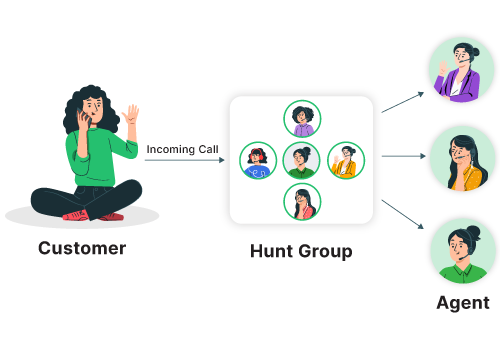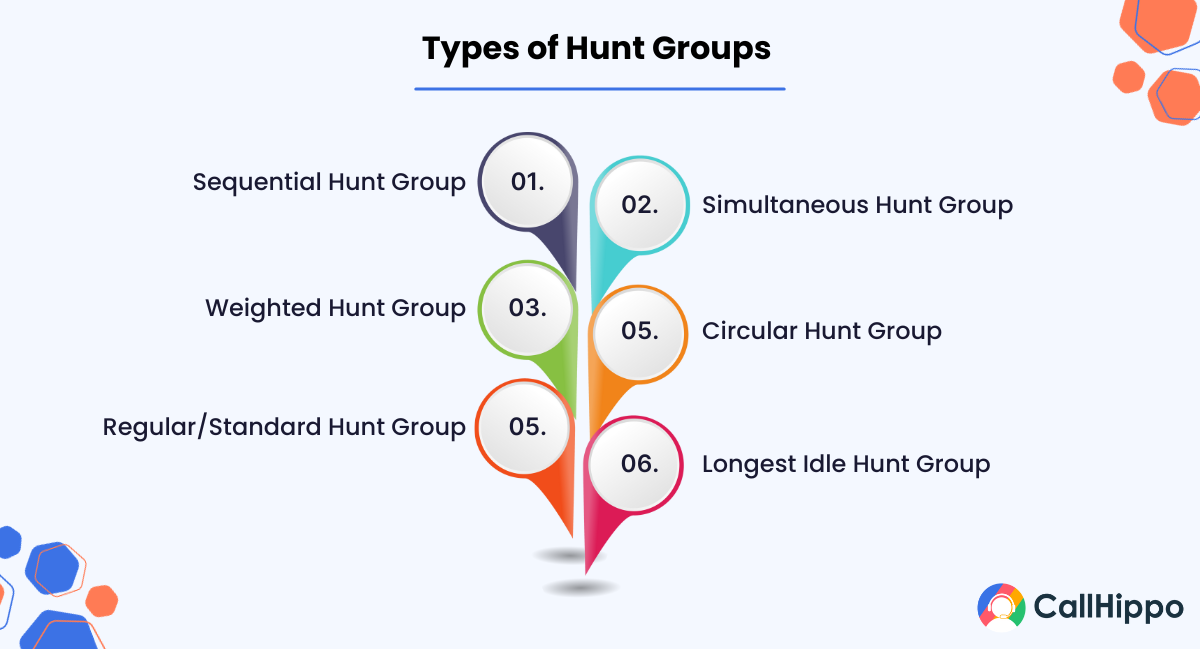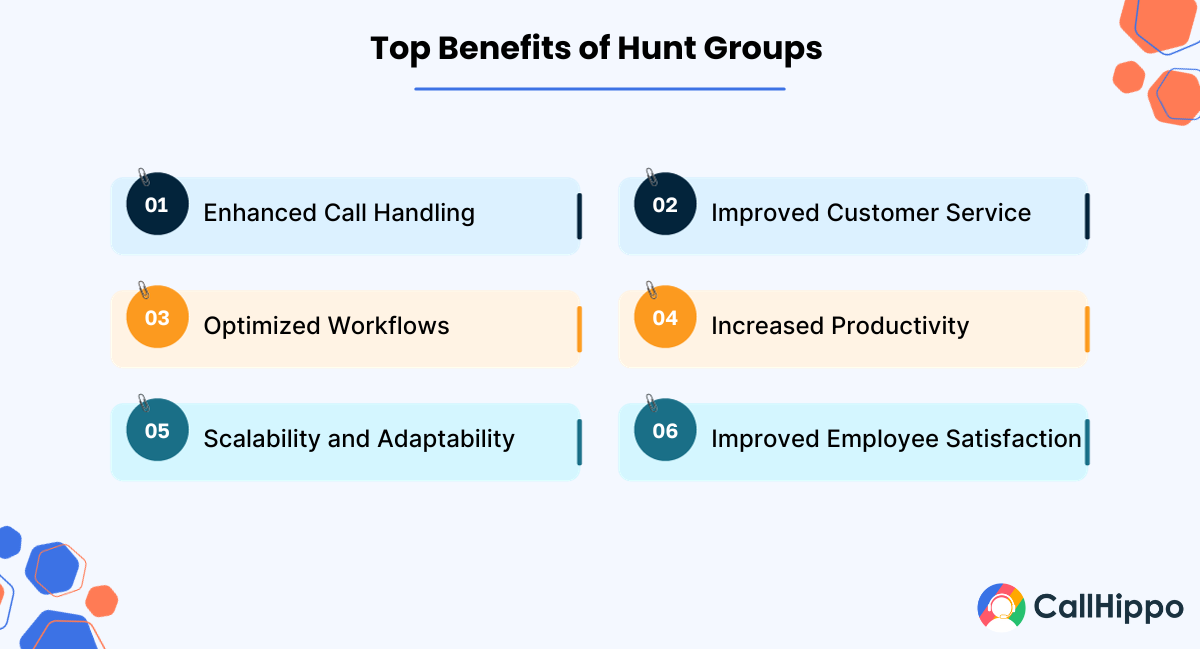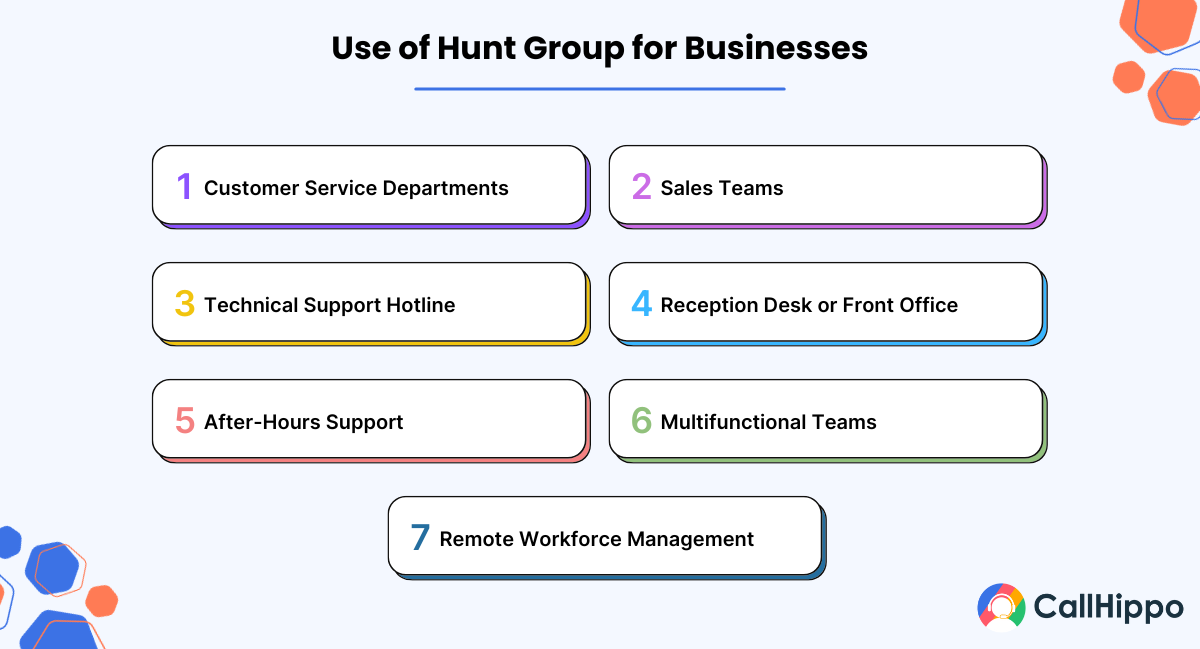Efficient call routing plays a pivotal role in ensuring seamless connectivity within organizations. One such mechanism employed for optimized call distribution is the concept of a “Hunt Group.” This system is designed to efficiently manage incoming calls and ensure they reach an available agent, thus enhancing customer service and organizational productivity.
What Is a Hunt Group?

A Hunt Group, also known as a Call Hunt or Ring Group, is a feature within telecommunications that enables incoming calls to be routed to a predefined group of extensions or phones. The primary objective of a hunt group phone system is to evenly distribute incoming phone calls among a set of designated phone lines or extensions, reducing the chances of missed calls and improving the chances of a prompt response.
Consider tailoring your Hunt Groups based on the specific needs and workflow of your organization. Use different distribution logics wisely, such as sequential ringing for structured call handling or simultaneous ringing for prompt responses, to optimize call routing, and enhance overall communication efficiency.
How Does a Hunt Group Work?
The operation of a Hunt Group typically involves several key components and a predefined set of rules or algorithms:
- Group Formation: Initially, a group of phone lines or extensions is identified and designated as part of the Hunt Group. These could be individual phones, departments, or specific teams within an organization.
- Call Distribution Rules: Various distribution algorithms can be employed within a Hunt Group, such as sequential ringing, simultaneous ringing, or weighted distribution. In sequential ringing, the system tries each extension in a predefined order until an available one is found. Simultaneous ringing routes the call to all designated extensions at once. Weighted distribution assigns a higher probability of receiving a call to certain extensions based on predetermined criteria like skills, workload, or seniority.
- Routing Logic: When an incoming call is directed to the Hunt Group number, the system applies the defined distribution logic to decide which extension(s) should receive the call first.
- Alerting Process: Based on the distribution rule, the system starts ringing or alerting the designated extensions simultaneously or sequentially. Once an available extension is identified, the call is connected, and the other phones stop ringing.
- Fallback Procedures: In case none of the designated extensions are available or responsive, Hunt Groups can be configured to implement fallback procedures, such as routing the call to voicemail or another predetermined destination.
Hunt Groups vs. Ring Groups
Hunt Groups and Ring Groups are both features used in telecommunications to manage incoming calls within an organization. While they share similarities in their fundamental purpose of distributing calls among a group of extensions, there are distinct differences in their functionalities and implementations.
| Features | Hunt Groups | Ring Groups |
| Call Distribution Logic | Utilizes various algorithms like sequential, simultaneous, or weighted distribution for call routing among designated extensions. | Rings all designated extensions simultaneously without employing sequential ringing. |
| Sequential Ringing | Employs sequential ringing, trying extensions in a predefined order until an available one is found. | Lacks sequential ringing, all extensions ring simultaneously without a specific order until someone answers. |
| Routing Logic | Incorporates complex routing logic to determine which extension receives the call first based on predefined rules or algorithms. | Lacks sophisticated routing logic, simply ringing all extensions at once without specific criteria or sequencing. |
| Functionality | Offers different distribution methods (sequential, simultaneous) and may include fallback procedures if none of the designated extensions are available. | Focuses on simultaneous ringing of all designated extensions without alternative call routing options. |
| Intent of Usage | Used when structured call distribution is needed, such as directing calls to specific departments or teams based on predefined rules or priorities. | Suitable for scenarios where multiple people or departments need to be reached simultaneously without a specific order of preference. |
Call Distribution Logic
- Hunt Groups: Utilize various call distribution algorithms like sequential ringing, simultaneous ringing, or weighted distribution. Calls are directed based on predefined rules or sequences among designated extensions.
- Ring Groups: Ring all designated extensions simultaneously when an incoming call is received without employing sequential ringing. All extensions ring concurrently until someone answers.
Sequential Ringing
- Hunt Groups: Employ sequential ringing where the system tries each extension in a predefined order until an available one is found.
- Ring Groups: Lack sequential ringing; all designated extensions ring simultaneously without a specific order until someone answers.
Routing Logic
- Hunt Groups: Have complex routing logic to determine which extension should receive the call first based on predefined rules or algorithms.
- Ring Groups: Lack sophisticated routing logic, simply ringing all extensions at once without specific criteria or sequencing.
Functionality
- Hunt Groups: Provide options for different distribution methods (sequential, simultaneous) and may have fallback procedures if none of the designated extensions are available.
- Ring Groups: Focus on simultaneous ringing of all designated extensions, aiming to connect the call with the first available person without alternative call routing options.
Intent of Usage
- Hunt Groups: Often used when a structured call distribution system is required, such as directing calls to specific departments or teams based on predefined rules or priorities.
- Ring Groups: Suitable for scenarios where multiple people or departments need to be reached simultaneously without a specific order of preference.
These differences delineate how Hunt Groups and Ring Groups handle incoming calls, their distribution methods, and the level of sophistication in call routing mechanisms, allowing organizations to select the most suitable option based on their specific communication needs.
Types of Hunt Groups
Hunt Groups, also known as Call Hunt or Ring Groups, are versatile call routing mechanisms used in telecommunications to distribute incoming calls among a defined group of extensions or phones. These groups are flexible and can be configured in various ways to suit different organizational needs. Here are several types of Hunt Groups:

1. Sequential Hunt Group
In a Sequential Hunt Group, incoming calls are directed to extensions in a predefined sequence or order. The system tries each extension one by one until an available one is found or until it reaches the end of the list.
Sequential Hunt Groups are useful when calls need to follow a specific hierarchy or order, directing calls to departments or individuals based on a predetermined sequence.
2. Simultaneous Hunt Group
In this type, all designated extensions ring simultaneously when an incoming call is received. The goal is to connect the call with the first available person among the extensions.
Simultaneous Hunt Groups are beneficial in scenarios where immediate availability from any of the listed extensions is equally acceptable or when time-sensitive responses are needed.
3. Weighted Hunt Group
Weighted Hunt Groups assign different priorities or weights to each extension within the group. Calls are then distributed based on these predefined weights, giving higher priority to specific extensions over others.
Weighted Hunt Groups are employed when certain extensions or individuals need to receive a higher volume of calls based on their expertise, seniority, or specific skill set.
4. Circular Hunt Group
In a Circular Hunt Group, calls are distributed in a circular manner among the designated extensions. When a call is received, it starts ringing the first extension on the list. If that extension is unavailable, the system moves to the next in a circular fashion until an available extension is found.
Circular Hunt Groups are suitable when fairness in call distribution among team members or departments is desired, ensuring equal chances of receiving incoming calls.
5. Regular/Standard Hunt Group
This type of Hunt Group follows a basic distribution logic where calls are distributed among the designated extensions without any specific weighting, sequence, or simultaneous ringing.
Regular Hunt Groups are ideal for scenarios where a simple call distribution mechanism is sufficient, and no specific prioritization or sequence is required.
6. Longest Idle Hunt Group
Longest Idle Hunt Groups route calls to the extension that has been idle (not on a call) for the longest period among the designated extensions.
These groups are beneficial in ensuring that calls are routed to the extensions that are most likely to be available due to their recent inactivity.
Each type of Hunt Group offers distinct functionalities, allowing organizations to customize call distribution based on their specific needs, priorities, and workflows. By understanding these variations, businesses can effectively implement the most suitable type of Hunt Group to enhance their communication systems and improve overall efficiency in handling incoming calls.
You May Also Read : 10 Best Call Management Systems For Businesses
Benefits of Hunt Groups
Hunt Groups, a feature in telecommunications, offer several advantages to organizations seeking efficient call handling and distribution. These benefits cater to improved customer service, streamlined workflows, and enhanced productivity within the organization. Here are the detailed benefits of using Hunt Groups:

1. Enhanced Call Handling
Hunt Groups ensure that incoming calls are directed to a group of designated extensions or phones. Using various distribution algorithms like sequential ringing or simultaneous ringing, these groups increase the likelihood of calls being answered promptly.
While hunt groups ensure efficient call distribution, maintaining high call quality is equally essential for delivering excellent customer service. Implementing a structured monitoring call quality process helps businesses analyze call performance, identify areas of improvement, and enhance overall communication effectiveness.
By distributing calls among multiple extensions or team members, Hunt Groups minimizes the chances of missed or unanswered calls, leading to improved communication with customers or clients.
2. Improved Customer Service
Calls are directed to the most appropriate personnel or department based on predefined rules or sequences within the Hunt Group. This ensures that callers reach the right individuals, improving customer satisfaction and reducing call transfer or waiting times.
Hunt Groups allow calls to be routed to specific teams or individuals possessing the necessary expertise or skills to address customer inquiries or resolve issues effectively.
3. Optimized Workflows
Hunt Groups streamline call distribution by employing different distribution logics. Sequential, simultaneous, weighted, or other methods ensure calls reach the right people or departments, improving overall workflow efficiency.
By routing calls to designated groups or teams, Hunt Groups facilitate better collaboration and coordination among team members, leading to quicker issue resolution and decision-making.
4. Increased Productivity
With a structured call distribution system, employees spend less time handling missed or misplaced calls and more time attending to relevant customer queries or tasks, leading to increased productivity.
Hunt Groups enable better focus and concentration on tasks as they minimize disruptions caused by unnecessary or irrelevant calls, allowing employees to concentrate on their core responsibilities.
5. Scalability and Adaptability
Hunt Groups are flexible and scalable, making them suitable for both small businesses and larger enterprises. They can easily adapt to changing business needs by adding or removing extensions from the group.
Organizations can customize Hunt Groups according to their specific requirements, choosing the type of group and distribution logic that best suits their communication needs.
6. Improved Employee Satisfaction
By efficiently managing incoming calls, Hunt Groups reduce the stress associated with handling a large volume of calls, leading to improved employee satisfaction and reduced work-related stress.
Employees experience clearer communication channels, as calls are directed to designated individuals or teams, avoiding confusion about call responsibilities.
How do Businesses Use Hunt Groups?
Here are various use cases depicting how businesses employ Hunt Groups in their day-to-day operations:

1. Customer Service Departments
A business sets up a Hunt Group for its customer service department. Incoming calls are distributed among a group of customer service representatives. Sequential ringing ensures that calls follow a specific order, allowing the most experienced representatives to handle complex inquiries first. Simultaneously, ringing ensures prompt responses, reducing wait times for customers seeking assistance.
2. Sales Teams
A company configures a Hunt Group for its sales team. Calls are routed to multiple sales agents simultaneously, ensuring that any available agent can handle incoming sales inquiries or close deals promptly. Weighted distribution may prioritize senior salespeople or those specializing in specific products, ensuring appropriate leads are directed to the most suitable individuals.
3. Technical Support Hotline
A tech company establishes a Hunt Group for its technical support hotline. Calls are distributed among a team of support engineers based on their expertise or availability. Calls can be set to ring multiple engineers simultaneously to ensure quick resolution of technical issues or can follow a sequence to connect callers to specialists in a particular technology or product.
4. Reception Desk or Front Office
A business sets up a Hunt Group for its reception desk or front office. Incoming calls to the main company line are distributed among receptionists or administrative assistants. Sequential ringing allows calls to be directed to the first available receptionist, ensuring that all incoming inquiries or calls are promptly addressed, improving customer service and office efficiency.
5. After-Hours Support
A service-oriented company implements a Hunt Group for after-hours support. Calls received outside regular business hours are directed to a group of on-call staff or a designated team. Calls can be routed in a circular manner to ensure equitable distribution among the team members, providing round-the-clock assistance to customers.
6. Multifunctional Teams
A project-based team utilizes a Hunt Group to streamline communication among its members. Calls intended for the project team are directed to a group of project managers, developers, and stakeholders. Simultaneous ringing ensures that any available team member can quickly address project-related calls, fostering better collaboration and timely decision-making.
7. Remote Workforce Management
A company with remote workers configures a Hunt Group to manage incoming calls for remote employees. Calls are distributed among remote team members, ensuring that remote workers remain connected to customer inquiries or internal communications. Sequential or simultaneous ringing ensures that remote employees can promptly address calls, maintaining productivity regardless of their location.
By adopting Hunt Groups in these diverse use cases, businesses optimize their call handling processes, streamline workflows, improve customer service, facilitate team collaboration, and effectively manage communication, contributing significantly to their operational efficiency and success.
Conclusion
Hunt Groups stand as a versatile and powerful tool within modern communication systems, offering businesses a comprehensive solution for efficient call handling, streamlined workflows, and enhanced customer service. These groups, with their various distribution logics such as sequential ringing, simultaneous ringing, or weighted distribution, empower organizations to tailor their call routing processes according to specific needs, whether it’s directing calls to designated departments, teams, or skilled individuals.
FAQs
1. What are circular hunt groups?
Circular Hunt Groups distribute incoming calls among designated extensions in a circular manner. When a call is received, it starts ringing the first extension on the list. If that extension is unavailable, the system moves to the next in a circular fashion until an available extension is found.
2. What is a hunt group in the telephone?
A hunt group, in telephony, is a feature that allows incoming calls to be distributed among a predefined group of extensions or phones. It employs various algorithms to determine the order in which extensions receive calls, ensuring efficient call handling within an organization.
3. How Many Multiple Hunt Groups Are Possible?
The number of multiple Hunt Groups that can be created typically depends on the capabilities of the telephone system or communication infrastructure in use. Many systems allow the creation of multiple Hunt Groups to manage different departments, teams, or functions within an organization.
4. Is It Possible to Reassign Agents to Multiple Hunt Groups?
Yes, in most cases, agents or extensions can be reassigned to multiple Hunt Groups. This flexibility allows businesses to optimize call handling by assigning agents to different groups based on their skills, availability, or specific needs of the organization.

Subscribe to our newsletter & never miss our latest news and promotions.










